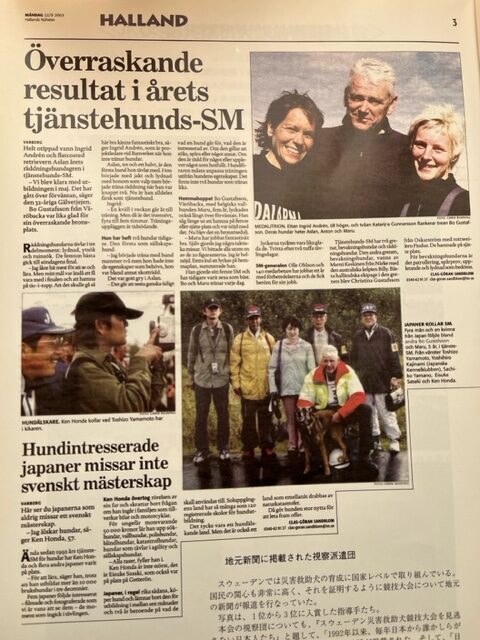序文/introduction
札幌転勤が急に決ったため、親戚、ご近所や知り合いにも、何の前触れもなく移ってきたように思う。
私より犬のことを心配している友人が多いことも今回、発見した。
私が札幌に引っ越すと話し始めると、十中八九、「犬はどうするの?」という質問が発せられた。札幌に来てからも私の留守中、「犬は3頭いますか?みんな(犬)元気ですか?」という電話がかかってきたというし、私が札幌で生活を始めると、犬の様子を見に遠路訪ねて来て、犬の世話をしてくださった友達もいた。
私は犬を養っていると思っていたが、どうやら私の人間関係は、犬によって構築され養成されているところが大きいということを、認めないわけにはいかなくなった。
犬との札幌での生活! 犬好き、北海道大好きの私が、この両方を手にした生活です。
2002年5月
札幌にて
山野 幸子
Because of the sudden decision to relocate to Sapporo, I did not have enough time to inform my relatives, neighbors, and acquaintances. Rather than myself, I also discovered that many of my friends were more concerned about my dogs due to the relocation.
When I started informing about my move to Sapporo, the question was almost always, “What about the dogs?”
When I started living in Sapporo, I received calls asking, “Are they (the dogs) doing well?” Some friends came to visit me from a long distance to check on my dogs and took care of them.
I could no longer deny that my human relationships are largely built and nurtured together with my dogs.
Living with three dogs in Sapporo! This is about my life as a dog lover and a big fan of Hokkaido.
May 2002
in Sapporo
Sachiko Yamano
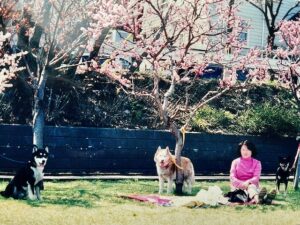
From left to right, Taro, Marin, me and Patch. Photo taken by Ms. Keiko Kuwabara who visited us from Tokyo.
再び札幌で暮らして 犬の一家と住む
2001年の9月末、私は1960年代半ばに中学3年間を過ごした札幌に転勤になった。1998年と2000年に、一緒に暮らしてきた両親が相次いで逝ってしまった。千葉県船橋市の自宅で、私は同じく残された犬3頭とともに暮らしながら、東京の勤務先に通う生活をその後1年半続けた。
転勤の話があったとき、私は真っ先に兄弟2人とそれぞれの家族に伝えた。私にとって札幌はなつかしい大好きなところではあるが、一人で引っ越しして生活するというのは、はじめての経験だ。
私の弟たちは、興奮気味に大賛成だった。それぞれ札幌での思い出は、深く心に染込んでいるのだ。兄弟たちも両親を偲びながら、「私たち家族には一番楽しかった思い出の土地だからね」と同じ想いだった。
札幌の西区福井に住む中学の同級生が、自宅の前に貸家があると連絡してくれた。大家さんに、犬を3頭飼うことの了解も得てくれたので、早速借りることに決めた。この当時は、一般的に言えば、日本の家庭では小型犬よりも日本犬や中型や大型犬を家庭で飼う人たちも多かった。犬と一緒に転勤することは、個々人の事情なので、社会や職場のサポートは期待できなかった。しかし時代を経て今では会社や職場の転勤の規則内で、実際には柔軟な適用がされているはずだ。今では犬は家族の一員としての存在が認められてきた。しかし当時は、一般的には、集合住宅に住まないと社宅扱いにならず、しかし集合住宅で犬が入れるところはほとんどなかった。犬と住める一戸建ての場合は、勤め先のサポートを離れて個人の選択にまかせられる。当たり前とは言え、家を探すのも自力でやって、経費は自己負担になる職場が多かった。私の職場もそうだったのだが私は札幌では大丈夫、問題なく簡単に見つかると、楽観視していた。あとでわかったことだが、札幌では関東圏よりも早く、犬は大型犬も小型犬も、家の中で飼うことが浸透していたことも理由の一つと思われた。犬3頭が、部屋に入ってくるとなれば、別の借り手を待つ方を選ぶことだろう。
赴任までに前述の中学の同級生だった竹永さんが見つけて交渉してくれたので、これで私もどんなに助かったかわからない。引っ越し初日に私が福井の家に到着すると、竹永さんが一家で引っ越しの手伝いに来てくれた。その温かさにほっとして元気が湧いた。それから2年8月の間、お向かいの竹永さん一家が家族のように何かと力になってくださった。竹永家ではラブラドールレトリーバー、ハルちゃんを末っ子のように可愛がっていた。
私の犬は、11歳のハスキー犬、4歳の日本犬(北海道犬と柴犬のミックス)、3歳になる彼らの息子犬の一家である。羽田から札幌まで犬は、私と同じ航空機に乗るが、手荷物扱いと貨物扱いあるそうだ。しかし、結局犬の搭乗手続き場所と、料金が違うだけで、いずれの手続きをしても、犬が乗る席は貨物席だ。大切に扱われる様子を見せてくれたので、少し安心した。
西区、福井の緑地帯
4LDKの庭付きの1戸建てを借りて、1.5畳平均の犬舎を3つ用意した。いままでこの犬たちには、犬専用の小屋はつくってあげたことはなかった。しかし大家さんがいいと言ってくださる言葉に甘えて、1日中、借りた家の中だけに入れておくというのには遠慮があった。。
西区福井の家から白石区本通りの事務所まで、宮の森や円山を経由して車通勤した。北1条通沿いの以前住み慣れた周辺は、40年の歳月とともに変貌はなはだしい札幌のなかで、奇跡的にほぼそのまま残っていた。最初のうちしばらくは側を通過するたびに、亡くなった両親と叔母に朝は「行ってまいります」と挨拶をした。帰途も以前の家付近では、「今日も無事ありがとうございました」とお礼を言った。朝も夜も眺めのよい通りを選んで通い、秋の札幌の魅力を満喫した。
ところで、私の犬の名前は、父犬・母犬・息子の順に、マリン・パッチ・タロと言う。マリンは茶白でブルーの目のハスキー犬。パッチは中型日本犬で、かつて犬といえば好まれて最も普及していた黒葛で四ツ目と言われた(目の上に白い星がある)タイプ。タロはそのマリンとパッチのミックス犬。 お腹を含む胴体の下の半分が白いところ、片方の目が青いところはハスキーから受け継いで外見はほぼハスキーだが、どことなく和風である。ある日散歩の途中で、タロを不思議そうな顔をして見ていた人が「この犬はハスキーですか?」と聞いたので、ふとタロを表すよい答えが浮かび「ニホンハスキーです」と言った。その人は「あぁ、そうですか」と、わかったようにうなずかれたことがあった。
家の斜め前には、札幌市福井緑地帯(公園)の入り口がある。福井はその名のとおり、福井県からの移住者によって開拓されたところで、その歴史を語る資料館もある。福井緑地帯は発寒川とその交流が東西に流れ、流域を延々と歩きながらあたりを眺めると、まじかの樹木が深い山々に連なっている。夕映えの紅葉の山々にとり囲まれて、犬たちとひたすら歩く。犬との散歩も30分で戻るのはもったいない。休日は帰り道があることをつい忘れて、片道2時間も歩き続けたことがあった。
発寒川の辺り
9月から札幌に住んでやっと6ヶ月になろうとしているのに、我家に近い発寒川周辺では次々と“事件”が起こった。すでに思い出がいっぱいの発寒川には人一倍愛着がある。
(1)パッチがおぼれた!
10月、雨が降った翌日は、川の水量も増していた。「いけない」と思いつつもあたりにひと気がないのを確かめてから、パッチを放した。
しばらくあちこちと遊んでいたパッチが、急に駆け出して、川の中に突進して行った。飛び跳ねた魚をつかまえようとしたらしく、果敢に川に飛び込んだのだ。水溜りしか水を知らないパッチは、足がつかない状態にあわてて、なにやらもがいている。とても泳いでいるとはいえない有様で、私も「パッチ!パッチ!パッチ!」と絶叫した。あとで聞くと、どこかで必ずひっかかるように浅くなっているそうだが、私も相当とり乱してしまった。パッチはその日は終日、静まり返って落ち込んでいた。翌日から数日間は、川のそばに行くとこわがって抱いてくれとせがんだ。
(2)マリン、また、家を出る
引っ越してきて間もない頃、通勤の道順をたどたどしく車を運転していた朝、電話が鳴った。車を止めてでると、大家さんの声だ。
「山野さんのハスキーが、ひとりで歩いているのを息子が見たというけれど、ひとりで散歩をするの?」
「とんでもない!自分ではなかなか帰ってこられない犬なのです」と答えて、すぐ家に引き返した。
もともとマリンは、1歳になったばかりと思われる頃、千葉県の動物管理(愛護)センターで引き取りの飼い主に出会えなかったのだ。事情があって初めて管理センターに寄った母が、帰ろうとするとマリンが立ち上がって後追いをした。母は人にも動物にも、心をこめて丁寧に接する人で、そのまま置いて帰ることができなかった。センターの職員と相談の上、自分が飼い主であるという手続きと罰金を支払って、かなり遠方であったから犬を乗せられる「赤帽」という宅配車で連れて帰ったのだった。まだ条例が改正される前で、翌日殺処分される犬であっても、純血犬の場合は、飼い主以外の人には引き取らせなかった。商品価値がある純血犬は、トラブルになる可能性があるというのがその理由だった。センターの職員が母の気持ちに臨機応変に対応してくれた結果、マリンは我家に来たのだった。元の飼い主をチラシや広告欄で捜したが結局見つからなかった。今でもマリンはどこから来たのだろうと思う。行方がわからず悲しんでいたはずの元の主人に、あれから11年、今札幌でファミリーまでつくって暮らしてしいることを知らせてあげたい思いがする。
マリンは家出が常習なので、首輪に金属プレートをはめ込み、さらに名札をつけている。文字通り「札付き」犬なのだ。帰宅すると、家の周辺には近所の方々が心配そうに出ておられる。
私の同級生、竹永さんは、すでに自分の犬の引き綱(リード)を持って、見かけたという情報をたよりに、川の上流の散歩道に出掛けたという。私は警察と保健所に連絡し、あとは捜しながら電話を待つしかない。結局、自分にずっとついて来たという方が、電話をくださって、引き取ることができた。大家さんが言われた引き取り場所まで、車で連れて行ってくださった。
川の流域の散歩道で、雄の北海道犬(アイヌ犬)とその飼い主の後を、付いて歩いたそうだ。仲良く散歩していたが、その人のお宅に着いて、マリンも一緒に入ろうとしたら、さすがにそのアイヌ犬に怒られたそうだ。
出勤前の私がマリンと遊んだあと、そのままうっかりつなぎ忘れてしまったのが、今回のお騒がせの原因だった。マリンはスタスタそのままいつもの散歩道に出て行き、やさしそうな人と犬の後を、付いて離れなかったのだ。
(3)タロ、カモとにらめっこ
初冬、発寒川にもカモが飛来する。日中、20~30羽のカモの群れにみとれていると、犬たちも興味津々で、橋から身を乗り出している。
夜中近くに川辺りを歩いているうちに、成犬になってからは放したことのないタロを、この誰もいない広場で、放してやりたい衝動に駆られた。タロは呼んだら、すぐ戻って来るからまずまず安心だ。タロをパッチとともに放すと、2頭ともいつもとは様子が違って、瞬く間にどこかに駆け出して行った。薄明かりの中を見るとタロは、川ふちの石の上でカモをじっとみている。今にも川に飛び込んで、捕まえてくるような勢いだ。タロが首尾よく、カモを捕らえて持って来ても、私は困る。それよりタロが川に飛び込んで、心臓麻痺にでもなったら、一大事だ。私は、これから犬は絶対に放しません、と大急ぎで誓い、大声でパッチとタロの名前を連呼した。しばらくして、パッチがどこからともなく帰って来た。一度川に落ちて怖い目にあっているので、遠巻きに眺めていたらしい。やがてあきらめたのか、目を輝かせ息を弾ませながら、タロが戻って来た。この出来事以後は、私は犬を放すことは、本当にやめた。
(4)自転車で3頭引き
発寒川の周辺は、歩行者用通路とともに、サイクリングロードが延々と続く。自転車の左サイドにマリンとパッチ、右サイドにタロをつないで走る。左右につないだマリンとタロが、鼻先を争う先頭争いをするため、自転車ごと私を乗せたまま疾走することになる。パッチも負けずについてくる。サイクリングロードだから前方はどこまでも広がっているが、脇を通っている歩行者用通路にいる人にとっては、「何だ、あれは!」と驚くほどの猛スピードで、自転車が通過することになる。見ている人がいて、犬ぞりレースに出る練習をしないかと誘われたときには、何か認められたようで嬉しかった。
もちろん、認められたのは、マリンとタロの力まかせの疾走だ。ちょうど犬ぞりレースが稚内を皮切りに北海道各地で注目されはじめた頃で、親切に私たちに走るべき場を教えてくださったのだ。
犬3頭に引っ張られて、得意になって自転車に乗っていたサイクリングロードで、私が大けがをしなかったのは奇跡に近いと、今思い起こすとぞっとする。
札幌の冬道
札幌の雪道や凍った通りでは、慣れない人はころぶから大変危険だと、冬を迎える前に、近所でも職場でも親切に心配してくださった。冬の札幌の路上は転びやすいことは重々承知しているつもりだった。早々とすべての靴底には滑り止めを貼ってもらい、最先端装備の、つめ(金具)がついたブーツを何足か購入した。どれが実際に具合がよいかは、使ってみないとわからない。
しかし、このように準備した靴を履いていない間隙に、私は転倒して後頭部を強打した。MRIの結果は、「頭に異常ありません」と言われたが、間一髪であのまま脳震盪か脳内出血を起こしてもおかしくないほど恐ろしい体験だった。さらに不注意から真冬に足の指を一本、骨折したため、1ヶ月間ギプスをはめて過ごした。
札幌の道路も歩道もぴかぴかに磨かれて、滑りやすい氷の上を歩くようなものだ。この滑り様は、東京や本州で想像している程度をはるかに超えている。スタッドレスタイヤが原因であるとか、さらに夜中に除雪車が道路を磨くからだと説明されている。札幌の気温がちょうど滑りやすい路面をつくるのだという説も聞いた。そもそも札幌のような180万人の人口を抱える大都市は、積雪の多い地域には皆無だそうだ。転倒事故に遭う確率は、人口が多ければ比例することだろう。
よくこのような危険な状態で、黙って冬を過ごしているものだと、私は不思議でならなかった。新聞の投書欄などによれば、札幌市民も決して、このままでよいとは思っているわけではなく、一番多い意見は「行政(市)が何か手を打つべきだ」次に「ボランティア活動として、市民一人ひとりが行政に協力する」というものだ。新聞も毎年、この課題を掲げて、時にはアンケートを行う。「行政」か「ボランティア」かがいつか解決するだろうという結論で、市民はゆるやかに結束するように見える。しかしながら、実は日常で聞く本音は「大自然が相手だからしょうがないね」と、だから冬は黙って乗り越えるものなのだ。これが道民が滑る道路でさえも本気で取り組まないのだとしたら、凄い哲学だ。私も本心から賛成だ。
雪掻き
北海道では「雪はね」という。冬に備えて、「ママさんダンプ」と呼んでいる底が深い巨大シャベルを2種類、こびりついた雪を払うための頑丈なほうき、車の雪とり用ブラシ、四角いスコップなど早々に除雪用具を買い込んだ。
主婦業の友人が「ママさんダンプ」という名は、この力仕事も主婦がすることになっているからだと、少々不服そうだ。家族の出勤前に家の前の雪掻きを終えても、帰宅時に日中積もった雪を除く仕事がある。とりわけ車通勤が多い北海道では、自宅前は平坦にしておかなければいけない。私が住む西区福井は山寄りで降雪量が札幌市でも多い地区だ。私もやってはみたがひと一人通れるようにするためには、1日がかりである。
転倒しやすい道路や歩道、つらい労働であるはずの雪掻きにもかかわらず、みんな文句も言わずに、冬を暮らしているように見える。はじめは、なぜ転倒防止対策や、すべらない通り道や安価な雪掻き業など競い合って、民間がお金儲けをしようとしないのか不可解だった。雪掻きはお金をもらってもご免こうむりたい、というのが大半の合意で、お金で来てもらえる人が見つかるだけで、ありがたいと考えた方がよさそうだ。そのうちこのような話は取るに足りない話で「これくらいの冬を乗り切らなければ、北海道人にはなれない!」という精神論が、ここに住むとぴったりと馴染むようになる。
犬のしもやけ
「星ひかり/赴任の友はしもやけに」という俳句は、私が帯広出張中、犬の世話をしてくれた山田さんが、JKC「家庭犬」に応募して特選になった。選者の評が添えられていた。
「あたたかい土地に住んでいた主人が、愛犬を連れて北海道に移り、迎えた冬の寒さは半端でないはず。澄み切った星空の下、友である犬は、“素足”がしもやけに…ほんのりユーモアも感じられます」
家の脇が、雪の集積場だったため、除雪車は我が家の塀に向けて雪を降ろして行く。そのうち家の塀を超えて雪の大きな山がこんもりそびえるようになる。
マリンはその山の上でじっとすわって、通りの人や犬を物珍しげに眺め、時には愛嬌をふりまいてかわいがられていたのだった。そのうち足の裏(パッド)がわれてきて、あかぎれのようなひびが入ってきた。見るからに痛そうなので、マリンが雪山に出られないように雪で埋もれた塀の2倍の高さで、選挙中、候補者のポスター貼りだすような高いべニア板のフェンスを立てた。外の雪の上が大好きなマリンを無理やり家の中に入れるようにした。
まもなく、マリンのすべての足の裏からピンクとベージュをミックスした見事なきれいな毛が、パッドを覆うように束になって噴きだしてきた。しかも雪道を歩くときには、滑り止めとしても役立ちそうだ。「すごい!」私は心からこの生理現象に尊敬の念を抱いた。タロもパッチも同様の毛の束は噴き出てきたが、12歳になろうとしているこのハスキー犬の遺伝子にはかなわなかった。
私がコートを掻き集め、靴を準備し、理屈を言っている間に、自前の毛皮と、収納していた防寒具を静かに装着して、はじめて北海道での冬を過ごした犬とその摂理に、深く感動したものだ。
一挙手一投足
せっかく秋に建てた庭の犬舎、雪にすっぽり埋まってしまった。外にいたいマリンも一緒に、結局全員、犬も家の中で一冬過ごした。
犬たちも家の中に閉じ込められる冬は、たいくつだったかもしれない。そのうえ私は、足の指の骨折とはいえⅠヵ月間は、ギプスをはめていたため、犬の散歩は全くできなかった。
Ⅰヵ月も運動できなかった犬の限界をみて、私もつめ付きブーツをはいて、2回に分けて雪道を散歩した。毎晩9時ごろ歩くのだが、全部終わるには2時間かかる。しかしつらいと感じるよりは、雪が舞っているなかを通り抜けるのは素敵な気分で、誰もいない銀世界を歩くというぜいたくを味わった。
ところで、「サッポロ・クラブ」の安田道夫会長(検事長、弁護士。札幌市や北海道への提言のための懇談会の座長としても貢献された)が、ご結婚前に赴任先で犬と暮らしておられたとき、その犬がいつも安田会長の後を追って、お風呂場までついてくるので、仕方なく見えるそばにおいて、お風呂にも入ったというお話をされたことがある。今の私はこのお話と全く状況が同じで、帰宅すると、3頭の6つの眼が常に私を追跡している。犬と暮らした経験がある方はご存知だが、犬は、主人がどの洋服を着ると何をするか、何かを持ったら次はどうするか、実によく観察している。犬の予想どおり事を運ばないということは、大変むずかしい。じっーと見つめる視線がうっとおしくて、家にすぐに帰りたくないと思ったこともある。私の場合は犬の一家が住む家に、私が帰宅するので、3対1では力負けしそうになる。今はかろうじて私が主導権を握っているので、帰宅後遅いときなど、どうしても行けないときは、「おやすみ」というと散歩は今日は行かないのだと、あきらめる習慣になった。
「毎晩、2時間も(前後の世話をいれるとすべての時間)あなたたちと外を歩き回ることはできないのよ。人間は読みかけの本を読まなければいけないからね」と言って、犬が体の下敷きにしている、北海道に来てからの私の愛読書、三浦綾子さんを引っぱり出すのだ。
しかし、犬の散歩くらいは、できれば夜も行ってあげたい。犬は「学校に行きたい」とか「新しいおもちゃが欲しい」とかほかのことで私にせがむことはないではないか、とちょっぴり反省するのだ。
北海道犬 ー アイヌ犬
私の家族は、北海道犬を長い間、家族一員としてきたため、私は今でも北海道犬に非常に関心がある。今いる犬はどれも北海道犬ではないのに、(社)北海道犬保存会(道犬保)には自分ができる協力をしたいと考えてきた。札幌に転勤になってまもなく、道犬保の本部展覧会が札幌の百合が原公園であると知って、札幌に来たばかりで、行ったことのない道を一人で、ナビもなかった車を運転し見に行った。現在の北海道犬の顔や体躯はどのようになっているのか、楽しみで前日から知っている北海道犬の眼やしぐさが浮んでくる。週末、札幌だけでなく、帯広など十勝で行われる獣猟競技や展覧会にも出かけるのは東京に住んでいても札幌に住んでも変わらなかった。
北海道犬の同好会はいくつかあるが、私が知っているのは、北海道犬の保存に1930年代から活動している愛好団体が法人化された、前述の「道犬保」である。もう一つ北海道犬協会という団体にも、知人や知っている犬が加入している。北海道犬協会は道犬保から分かれた団体で、道犬保を離れた理由は、北海道犬の狩猟性を評価の対象とするかどうか、ということが争点だったそうだ。もともと熊猟に欠かせなかったアイヌ犬(北海道犬)の狩猟性を、犬の標準体型との両輪で保存しようという道犬保に対して、狩猟性は現代の都会に住むペットに求める必要はないという考えが、北海道犬協会の主張だったようだ。すでに現在の北海道犬関係者にとっては、過去の経緯や争いは関係のないことであると思う。議論は現状から出発して、北海道犬の愛好者が一体となって交流できるようになりたいと、私は願っている。
道犬保の、北海道犬の保存という役割
一犬種について一つの団体を、日本犬の場合は文化庁が認可している。天然記念物というのは、「絶滅しないように、保護するねうちがあるため、法律で指定した自然物」であり、約1000件ぐらいの動植物や鉱物が指定されているという。したがって、選ばれた一団体には、犬を愛好すると同時に、犬種の目指す理想の姿や性質や能力を維持し、時代とともに人間社会に受け入れられるように進化させる役目がある。道犬保は、単なる愛犬家の集い以上の役目があるため、相当の費用が必要とされ、会員収入とわずかな文化庁からの補助では困難で、財政上は苦労が多いと想像できる。
血統書付き日本犬の保存会は、子犬を人から譲ってもらうときに、その時代と各保存会の相場や規定でお金を払うが、特別優れた血統や賞歴でもない限り、西洋犬の相場に比較すれば、桁が一桁少ないと言われ、私が知っている時代では気持ち程度のささやかな金額だった。私が知る範囲では、日本犬のどの犬種でも、傾向として、犬を売買して収入を得ることを、「犬で商売をする」と言ってよく言われなかった。日本犬の保存会は、もともと犬を職業にしている人より、犬が好きで犬を飼ってきた人が多いからだ。展覧会は、現在のように定期的に獣医さんに連れていって、必要な知識を得られる時代ではなかったため、飼育の経験者の失敗や成功、アドバイスなどの場としても貴重だった。
一方で、血統書付き西洋犬を中心とした日本を代表する団体は、生産者、すなわち、犬のプリーダー、犬の販売、展覧会でのハンドラーからトリミングや諸々の資格試験制度が併設されていた。その創設においては、畜犬業として産業の保護を含む業者側視点からを出発している。従って、日本犬が文化庁の所管だったのに対して、西洋犬は農水省の畜産局小動物係の所管だった。後者は主として業者の経済活動を念頭に設立された団体であったが、時代の推移とともに一般家庭の愛犬家を念頭に改革されてきた努力は並々ならないものがあると感じる。
北海道犬保存会に戻ると、よい北海道犬の作出と維持と発展という側面から努力している人たちにとっては、ボランティアや自己負担にも限界があると思う。収支に透明性を持たせながら、よい犬を継続的に作出して、愛犬家に渡していけるような財務状況をどうすれば改善できるのか、奮闘されている。よい環境で育てられる素晴らしい犬が国内で、そして近い将来、北海道と気候や生活スタイルが類似している点が多いとされる北欧はじめヨーロッパ、そして米国などでも、家族の一員として可愛がられてもらいたいと願っている。
北海道に住むと、衣類やシャンプーや化粧品などの日用品がスウェーデン、デンマーク、ドイツ、カナダ、米国オレゴン州などから、東京や関東圏とは別のトレードで普及している。私は夏休み中にスウェーデンのイエテボリ Göteborgの近郊で、災害救助犬の研修に参加したことがあった(注Ⅰ)。10日間ぐらいイエテボリに滞在したが、その気候と生活スタイル、街の雰囲気が北海道にとても似ていて、北海道犬にも適応しやすいところだと強く印象に残った。北海道は欧米との交流がもともと長く、関係も深い。日本の犬が海外と交流するのは、秋田犬関係者が先陣を切って尽力して来られたが、少しずつ、現在の規制や障壁を乗り越えて、北海道犬も世界の愛犬家に知ってもらいたい。
了
注Ⅰ 写真は、国際救助犬連盟(IRO)及びスウェーデン・ワーキングドッグ・アソシエーション(SBK)、スウェーデン・ケネルクラブ(SKC)主催で、スウェーデンのイエテボリ(Göteborg) 近郊のハランド(Halland)で2003年に開催された災害救助犬大会での見学・研修会。犬種や純潔種等は問わない。競技会に参加して、自分の飼い犬を訓練の成果を専門家に評価してもらう参加者が大半だった。
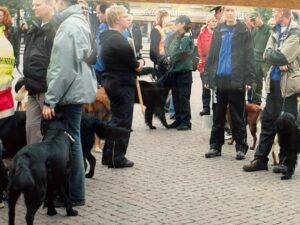
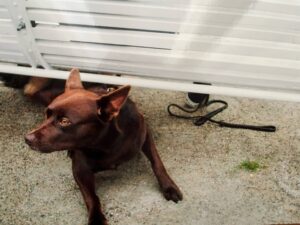
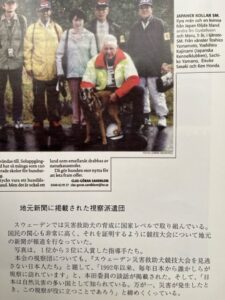
Living in Sapporo Again With a family of dogs
In 1998 and 2000, my parents who had lived with me passed away one after another. For the next year and a half, I lived in our house in Funabashi City, Chiba Prefecture, with my three remaining dogs and I commuted to work in Tokyo. At the end of September 2001, I was transferred to Sapporo, where I had spent three years of junior high school in the mid 1960’s.
When I heard about the transfer, I immediately informed my two brothers and their respective families. Although Sapporo is a place I fondly remembered and loved, it would be the first time for me to move and live alone. My brothers were excited and very supportive of the idea. Each of them had fond memories of Sapporo. They also shared the same sentiment, “For our family, Sapporo is the place where we had the most fun and happiest memories.”
A junior high school classmate of mine, Takenaga-san who lived in Fukui, Nishi-ku, Sapporo, informed me that she found a house for rent in front of where she lived. She also got the owner’s consent to allow my three dogs to live in the flat. As such, I decided to rent the house right away. At that time, generally speaking, many Japanese families kept medium or large-sized dogs at home rather than small indoor dogs which we see more commonly these days. Relocating with a dog is considered a private matter, so support from the society and the workplace could not be expected. However nowadays, within the respective rules of company and workplace transfers, there might be flexible approaches. Dogs are now recognized as regular members of the family. At that time however, employees had to live in an apartment or housing complex to receive housing allowance from the company, but very few housing complexes allowed dogs. In the case of private residence where dogs had more freedom, it was left to the individual’s decision, without the support of the individual’s company. Although it was the norm, many workers were on their own to find a home and were responsible for their expenses. I was optimistic that I would be able to find a place to live in Sapporo without any problems. I later found out that one of the reasons for this was that in Sapporo, keeping dogs, both large and small, inside the house was more prevalent than in the Kanto area. If three big dogs were to move in however, even in Sapporo, owners would generally choose to wait for other tenants.
I cannot express how much Takenaga-san helped me because she found and negotiated on behalf of me before I was assigned to the new location. When I arrived at the Fukui house on the first day of moving, Takenaga and her family came to help me move. Their warm welcome relieved and cheered me up. For the next two years and eight months, the Takenaga family across the street was dependable for me like a family.
The Takenaga family loved their Labrador retriever, Haru, as if she were their youngest child.
My dogs were an 11-year-old husky, a 4-year-old Japanese dog (a mix of Hokkaido and Shiba dog), and their 3-year-old son. From Haneda to Sapporo, the dogs boarded the same plane as me, but I was told that depending on size of dogs, they will be treated as either baggage or cargo. However, in the end, the only difference was the check-in area and the fare for the dogs. I found out that no matter which method is selected, the dogs will be seated in the cargo section. Nevertheless, I was a little relieved to actually see that my dogs were nicely mannered and taken good care by staff.
Fukui Greenbelt, Nishi Ward, Sapporo
The house I moved into was a four-bedroom house with a garden and in the garden, I prepared three 1.5-mat average-sized kennels. Until now, I had never built kennels exclusively for these dogs. Despite of the owner’s kind words, allowing my dogs to live without kennels, I hesitated to leave the three dogs inside the rented house all day long.
I commuted by car from my house in Fukui, Nishi Ward to the office on Hondori Street in Shiroishi Ward via Miyanomori and Maruyama. The neighborhood where I used to live along Kita 1 street had miraculously remained unchanged in the midst of Sapporo, which had been transformed drastically over the past 40 years. For a while in the beginning, whenever I passed by the house my family used to live on Kita 1 street, I would greet my parents and aunt in the morning, saying “I’m off to work”. On the way home, I thanked them for our safety (me &dogs) today. I chose streets with good views both in the morning and at night and enjoyed the charms of Sapporo in autumn.
My dogs’ names are Marin, Patch, and Taro, in the order of father, mother, and their son. Marin was a brown-white, blue-eyed husky dog. Patch was a medium-sized Japanese dog, a type of black and partial brown with white stars above the eyes, which used to be the most popular type of dog. Taro’s lower half of his body including his belly was white. He was bi eyed with one blue eye and brown for the other. As such, his coat and eyes seem to have been inherited from a Husky. Yet, although it is hard to describe in words, in some ways, he presented Japanese style (Wa-fu). One day on a walk, a stranger looked at Taro with a curious look on his face and asked, “Is this dog a husky?” I suddenly thought of a good answer to describe Taro and said, “He is a Japanese Husky.” The person nodded and said, “Oh, I see.”
Near our house, was the entrance to the Sapporo Fukui Greenbelt (park). As the name suggests, Fukui area in Sapporo was developed by immigrants mostly from Fukui Prefecture around 1880 of Meiji era. Hassamu river runs along the Fukui Greenbelt. A long walk along the riverbank reveals a deep mountain range of trees. Surrounded by mountains with autumn leaves in the evening, I walked with my dogs. It was a pity to return just after a 30-minute walk with the dogs and as such, on holidays, I used to walk for two hours one way, forgetting that there was another two hours waiting on our way back.
Along the Hassamu River
It had been almost six months since September, when I started living in Sapporo. Around that time, “incidents” happened one after another along the Hassamu River near our house. I could say that I have a strong attachment to the Hassamu River than others, which is full of memories.
(1) Patch has drowned!
In October, the day after it rained, the river rose. I knew I shouldn’t have done that, but after making sure there was no one around, I released Patch’s harness.
(3)Taro, staring at ducks
In early winter, ducks came to the Hassamu River. During the daytime, when I was fascinated by the flock of 20 to 30 ducks, my dogs also became curious that they leaned over the bridge to see the ducks.
As I walked around the river close to midnight, I felt the urge to let go of Taro’s leash in the empty square. Taro always had a leash on since he was an adult dog. I felt safe as I knew that Taro would come right back to me when I call him. When I let go of Taro and Patch, both acted differently from usual and ran away in a blink of an eye. Under the moonlight, I saw Taro staring at the ducks on a stone at the edge of the river. He looked as if he was about to jump into the river and catch the ducks. Even if Taro had successfully caught a duck and brought it back, I would have been in trouble. Also, if he had jumped into the river and have a heart attack, it would have been an emergency. I swore while in a great hurry that I would never release the dogs from now on, and loudly called out Patch and Taro’s names.
After a while, Patch came back out of nowhere. She had fallen into the river once and had a scary experience, so it seemed she had been watching from a distance. Eventually, Taro came back, his eyes shining and his breath puffing. He seemed to have given up going after the ducks, but still looked quite satisfied. After this incident, I truly stopped releasing the dogs’ leash.
(4)A Bicycle Pulled by Three dogs
A bike path extends along the Hassamu River, alongside the pedestrian pathway. I rode my bicycle with Marin and Patch on the left and Taro on the right. Marin and Taro fought to take the lead, and Patch followed without losing a breath. Accordingly, I had been pulled by them together with the entire bike.
The bike path and the road ahead were wide open, but to the people on the pedestrian pathway beside me were surprised saying, “What the heck was that?!” For those people, we passed by at an alarmingly high speed. I felt as if I was getting some recognition and felt satisfied when someone watching us asked if we would enter a dog sled race. Undoubtedly, Marin and Taro’s forceful sprint was approved. This was the time when dog sled races were just beginning to attract attention in various parts of Hokkaido, starting with Wakkanai; a city in Northern Hokkaido. The person kindly showed me where I should run with my dogs with promising potentials. Now as I reflect back, it is a miracle that I was not seriously injured on the cycling road where I was riding my bicycle with three dogs pulling me along.
Winter Roads in Sapporo
Before winter set in, people in my neighborhood and workplace kindly warned me about the dangers of slipping on Sapporo’s snowy and icy roads. I was well aware that it is easy to fall down on the streets of Sapporo in winter. I quickly acquired shoes lined with anti-slip material and purchased several pairs of latest boots with claws (metal fittings). I had to try them out to see which ones would actually work well.
However, before the preparations of these snow-proof shoes could be completed, I fell and hurt the back of my head; the MRI results showed “no abnormalities in my head,” but the experience was so horrific that I could have had a concussion or intracerebral hemorrhage at that point in time. I also inadvertently broke one of my toes in the middle of winter and spent an entire month in a cast.
The roads and sidewalks in Sapporo are so polished and shiny that it is like walking on slippery ice. The slipperiness is far beyond what one would imagine in Tokyo or mainland. In Sapporo, it is explained that studless tires are the cause and that snowplows polish the roads in the middle of the night. I have also heard the theory that Sapporo’s temperatures create just the right amount of slippery road surfaces. It is said that unlike large cities in the world with a population of around 1.8 million, Sapporo has an outstanding amount of snowfall. The probability of accidents involving falls is proportional to the size of the population.
I wondered how people could live through the winter in such dangerous conditions. According to newspaper columns, the citizens of Sapporo do not think that the situation should be left as is, and the most common opinion is that “the city government should do something about it” followed by, “each citizen should cooperate with the government through volunteer activity.” Every year, newspapers re-raise this issue and sometimes conduct surveys. Citizens seem to be loosely united under the assumption that either the “government” or “volunteers” will one day solve the problem. In fact, however, the real story we hear on a daily basis is that “it can’t be helped because we are dealing with Mother Nature” and that is why winter is something to be bear with in silence instead of facing. If this is the reality, I sincerely agree with.
Snow shoveling
In Hokkaido, snow shoveling is called “Yuki-hane” (snow shovel). In preparation for winter, I quickly bought snow removal equipment, including two types of huge deep-bottomed shovels that I call, “mama-san dump trucks,” a sturdy broom to remove sticky snow, a brush for removing snow from cars, and a square shovel.
A friend of mine who is a housewife is somewhat displeased with the naming, “mama-san dump” because housewives are supposed to do this heavy lifting too. Even if she finishes shoveling the snow that’s in front of her house before her family leaves for work, she still has to remove the snow that has accumulated during the day by the time of their return. Especially in Hokkaido, where many people commute by car, the home front of people’s houses must be kept flat. I lived in Nishi Ward, Fukui, which is near the mountains and has a lot of snowfall, even for Sapporo. I tried to shovel the snow around my house, but it took a whole day to make it passable for one person.
Despite the fall-prone roads and sidewalks, and the hard work of snow shoveling, everyone seems to be living through the winter without complaints. At first, I was puzzled as to why the private sectors did not try to profit by providing fall prevention measures, non-slip paths, and affordable snow shoveling services. Most agreed that they would not want to do snow shoveling even if it was paid, and they should be thankful that they could find someone willing to come for money. In time, this kind of talk becomes insignificant, and the mentality of “If you don’t get through this many winters, you won’t be a true Hokkaido person!” settles in when living here.
Dogs’ frostbite
The haiku, “Starlit sky, the master’s dog accompanying along, have got frostbite on its paws” was submitted to JKC members magazine “Kateiken” by Ms. Yamada, who took care of my dogs while I was on a business trip to Obihiro and won a special prize. It was accompanied by a review from the haiku’s critic. “For the owner and his/her dog, who had lived in a warm place and moved to Hokkaido, the winter cold must have been extreme. Under the clear starlit sky, the dog, who is his/her friend, gets frostbite on its “bare feet”…..” There’s a hint of humor in it.
The side of our house was a snow accumulation area, so the snowplow trucks were unloading snow toward the fence of our house. Eventually, a large pile of snow would rise over the fence of our house. Marin would sit on top of the pile and watch the people and dogs on the street with a look of curiosity, and sometimes would show off his charm and be adored by them. Eventually, the soles of his feet (pads) began to crack, as if they were chapped.
It looked painful, so we raised the fence twice as high as the snow-covered fence to keep Marin out of the snowy mountains, and put up a tall plywood fence like the ones used to put up election posters. We forced Marin, who loves to be outside on the snow, to come inside the house.
Soon, a stunningly beautiful mix of pink and beige hairs grew from the soles of all of Marin’s feet in bunches to cover the pads. They would be useful as non-slip pads when walking on snow-covered paths. Amazing! I sincerely admired this physiological change. Taro and Patch had spewed out similar tufts of fur, but nothing could compare to the genes of this 12-year-old husky.
While I was raking up my coats, preparing my shoes, and many other things, he was quietly putting on his own fur and the winter gear he had stored away. I was deeply moved by the dog and his providence as he spent the winter in Hokkaido for the first time.
Every single movement and behavior
The kennel in the yard, which we had built back in fall, was completely buried under the snow. Marin, who wanted to stay outside, and all the dogs ended up spending the winter inside the house.
It must have been tiring for the dogs to be confined inside the house all winter. In addition, I was not able to walk the dogs because I had to wear a cast for a month because of a broken toe. Seeing the limitations of my dogs that had not been exercised for a month, I put on boots with spikes and walked the dogs on snow-covered paths twice. When I returned from work, I would walk every night around 9:00 p.m. It would take me two hours to finish the entire walk. But rather than feeling exhausted, it felt fantastic to walk through the dancing snow, and I enjoyed the luxury of walking in an empty silver world.
By the way, Mr. Michio Yasuda, the president of “Sapporo Club” as well as a chief public prosecutor and a lawyer, once told me that when he lived with his dog at his new post before his marriage, his dog always followed him everywhere even to the bathroom, so he had no choice but to take a bath with him by his side where the dog could see him. Now, I was in the same exact situation. When I come home, I have three dogs with six eyes tracking me at all times. Those of you who have lived with dogs know that they are very observant of their owners such as, what owners wear, do, or even hold. There have been times when I didn’t want to return home straight away because I was pressured by those staring eyes. I felt as if I came home to a house where a family of dogs lived, and I often lost in a three-on-one fight for the control of power.
Now that I am barely in control, I have gotten into the habit of saying “good night” when I couldn’t go outside, such as when it was late when I arrived home from work, and then my dogs would give up, knowing that the walk is not going to happen today. I said, “I can’t walk around outside with you guys for two hours every night, if you consider other things that I do to take care of you guys. Also, humans have to read. I have to read a book.” And I pulled out my favorite book, written by Ayako Miura, which I have been reading avidly since I came to Hokkaido, and also which the dogs have been using as a base of their body. Despite of saying this, I would then want to walk the dogs again at night, thinking that the dogs never ask me for anything else, such as “I want to go to school” or “I want a new toy.” I felt a little sorry for them in such nights.
Hokkaido dog (Ainu dog)
My family has had a Hokkaido dog as a member of our family for a long time, and even till this day I remain very interested in Hokkaido dogs. Although I no longer keep Hokkaido dogs, I have always wanted to cooperate with the Hokkaido Dog Preservation Society (Do Ken Po) in any way I could. Soon after transferring to Sapporo, I learned that Do Ken Po was holding an exhibition at Yurigahara Park. So, I drove alone to the venue, with my car that wasn’t equipped with a navigation system which was normal back in the days, along roads I had never traveled before. Since the day before the event, I looked forward to seeing what the current Hokkaido dogs’ faces and physiques look like and recalled the eyes and behaviors of the dogs I have known. It was the same whether I lived in Tokyo or Hokkaido that I would go to tracing competitions and exhibitions held not only in Sapporo, but also in Obihiro and other areas in Tokachi on weekends.
There are many Hokkaido dog clubs today, but as far as I know, the aforementioned “Do Ken Po”, is the only incorporated association of dog lovers who have been active in the preservation of Hokkaido dogs since the 1930s. Another organization is the Hokkaido dog Kyokai (Hokkaido dog Association). The Hokkaido dog Kyokai is an organization that split off from Do Ken Po, and the reason for becoming independent from Do Ken Po was because there was a dispute over whether hunting qualities of Hokkaido dogs should be subjected to evaluation. Do Ken Po’s argument seemed to be that the hunting characteristics of Hokkaido dogs, which was originally an indispensable aspect for bear hunting, should be preserved along with the dog’s standard body shape. Whereas the Hokkaido Dog Kyokai insisted that hunting characteristics need not be sought in modern city-dwelling pets. I believe that for those already involved with Hokkaido dogs today, the history and disputes from the past are irrelevant. It is my hope that Hokkaido dog lovers will be able to interact as one.
Do Ken Po’s role in preserving Hokkaido dog
The Agency for Cultural Affairs has authorized one organization for each breed of dog. Natural treasures “are objects designated by law to protect them from extinction,” and about 1,000 plants, animals, and minerals have been designated as such. Therefore, the selected group has the role of not only loving dogs, but also maintaining the breed’s ideal form, characteristics, and abilities, as well as evolving them to be accepted by human society as time goes by. Since the Do Ken Po serves more than just a gathering of dog lovers, it requires a considerable amount of money, which is difficult to collect with just membership fee and a miniscule subsidy from the Agency for Cultural Affairs, and one can imagine that there are many financial difficulties.
When the Japanese dog preservation society receives a puppy, the organization pays according to the market price and regulations of the time. With the exception of puppies with particularly outstanding pedigree or awards, the amount is said to be lower than the market price for Western dogs. And in the times I know of, it was a modest amount of money of 5,000 yen/pup around the 1970’s. This tendency of breeding Japanese dogs to earn income through buying and selling, was not often referred to as “doing business with dogs”. The reason for this is that the preservation societies for Japanese dogs have always been composed of people who kept dogs for their love and personal interest rather than profession.
Exhibitions were also valuable as a forum for experienced members to share their successes and mistakes, as it was not the time, as it is today, when people could regularly take their dogs to the veterinarian and gain the knowledge and advice they needed.
On the other hand, the organization which represents pedigreed Western dogs was founded from the commercial perspective. For instance, dog breeders, dog sales, dog handlers at exhibitions, trimming, and various qualification examinations, and its establishments were taken into consideration. Thus, while Japanese dogs were under the jurisdiction of the Agency for Cultural Affairs, Western dogs were under the jurisdiction of the Small Animals Section of the Livestock Bureau of the Ministry of Agriculture, Forestry and Fisheries (MoAFF). Although the Western dog group was established primarily with the economic activities of the traders in mind, but as time has passed, it has made extraordinary efforts to reform itself to consider general home dog lovers.
Back to the Hokkaido Dog Preservation Society (DoKenPo), for those striving to create, maintain and develop good Hokkaido dogs, number of volunteers and amount of self-pay were limited. They are struggling to find ways to improve their financial situation so that they can continue to produce good dogs and pass them on to dog lovers. This is because while paying and receiving the necessary fees, people do not maintain transparency in their income and expenditures. I hope that wonderful dogs raised in good environments will be loved as family members in Japan and, in the near future, in Northern Europe, and the United States, where the climate and lifestyle are said to be similar in many respects to those of Hokkaido.
Living in Hokkaido, daily necessities such as clothing, shampoo, and cosmetics are spread from Sweden, Denmark, Germany, Canada, and Oregon USA, in a different trade than in Tokyo and the Kanto area. I had participated in a training program for disaster rescue dogs in Gothenburg, Sweden, during my summer vacation. I stayed in Gothenburg (Göteborg) for a week and was impressed by its climate, lifestyle, and city atmosphere, which is very similar to Hokkaido, and a comfortable place for Hokkaido dogs to live (note 1). Hokkaido has always had a long history of exchange with Europe and the United States and has had a close relationship with them. Akita dog lovers were the first to make efforts for Japanese dogs to interact with foreign countries, but little by little, we would like to overcome the current rules and barriers so that Hokkaido dogs can also be known to dog lovers all over the world.
note 1: Photos below show a visit and training session at the Disaster Rescue Dog Congress held in Halland near Gothenburg (Göteborg), Sweden. It was organized by the International Rescue Dog Federation (IRO), the Swedish Working Dog Association (SBK), and the Swedish Kennel Club (SKC) in 2003. Regardless of breed, purebred, and etc., the majority of participants in the competition and had their own dogs evaluated by experts on the results of their training.
-end
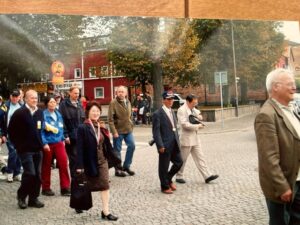
in Halland, Sweden, 2003
